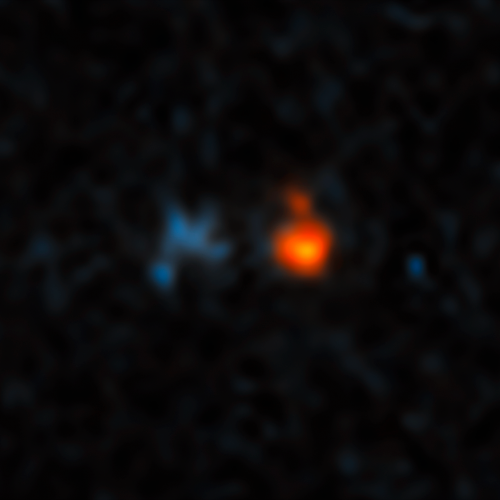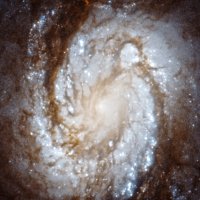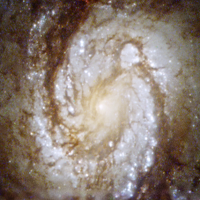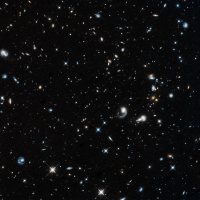
This is a Hubble Space Telescope image of a very distant quasar (at right) that has been magnified and split into three images by the effects of the gravitational field of a foreground galaxy (left).
The quasar would have gone undetected if not for the power of gravitational lensing, which boosted its brightness by a factor of 50. The gravitational field of the foreground galaxy (seen at left) warps space like a funhouse mirror, amplifying the quasar's light.
Shining with the brilliance of 600 trillion Suns, the quasar is fueled by a supermassive black hole at the heart of a young galaxy in the process of forming. The image shows the quasar as it looked 12.8 billion years ago — only about 1 billion years after the big bang.
The quasar appears red because its blue light has been absorbed by diffuse gas in intergalactic space. By comparison, the foreground galaxy has bluer starlight.
The quasar, cataloged as J043947.08+163415.7, could hold the record of being the brightest in the early universe for some time, making it a unique object for follow-up studies.

 This is a Hubble Space Telescope image of a very distant quasar (at right) that has been magnified and split into three images by the effects of the gravitational field of a foreground galaxy (left).
The quasar would have gone undetected if not for the power of gravitational lensing, which boosted its brightness by a factor of 50. The gravitational field of the foreground galaxy (seen at left) warps space like a funhouse mirror, amplifying the quasar's light.
Shining with the brilliance of 600 trillion Suns, the quasar is fueled by a supermassive black hole at the heart of a young galaxy in the process of forming. The image shows the quasar as it looked 12.8 billion years ago — only about 1 billion years after the big bang.
The quasar appears red because its blue light has been absorbed by diffuse gas in intergalactic space. By comparison, the foreground galaxy has bluer starlight.
The quasar, cataloged as J043947.08+163415.7, could hold the record of being the brightest in the early universe for some time, making it a unique object for follow-up studies.
This is a Hubble Space Telescope image of a very distant quasar (at right) that has been magnified and split into three images by the effects of the gravitational field of a foreground galaxy (left).
The quasar would have gone undetected if not for the power of gravitational lensing, which boosted its brightness by a factor of 50. The gravitational field of the foreground galaxy (seen at left) warps space like a funhouse mirror, amplifying the quasar's light.
Shining with the brilliance of 600 trillion Suns, the quasar is fueled by a supermassive black hole at the heart of a young galaxy in the process of forming. The image shows the quasar as it looked 12.8 billion years ago — only about 1 billion years after the big bang.
The quasar appears red because its blue light has been absorbed by diffuse gas in intergalactic space. By comparison, the foreground galaxy has bluer starlight.
The quasar, cataloged as J043947.08+163415.7, could hold the record of being the brightest in the early universe for some time, making it a unique object for follow-up studies.








Комментарии (0)